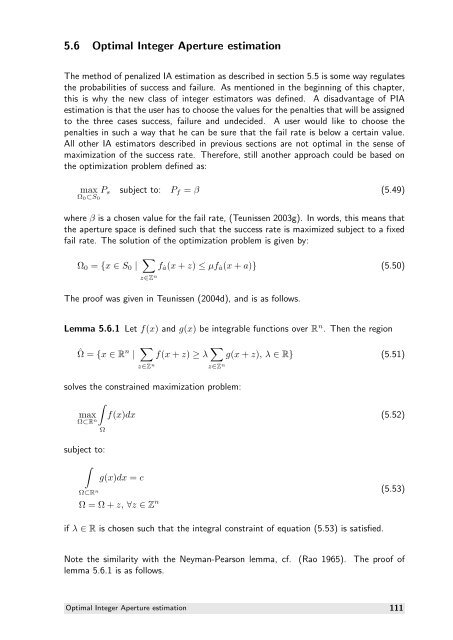The GNSS integer ambiguities: estimation and validation
The GNSS integer ambiguities: estimation and validation
The GNSS integer ambiguities: estimation and validation
Create successful ePaper yourself
Turn your PDF publications into a flip-book with our unique Google optimized e-Paper software.
5.6 Optimal Integer Aperture <strong>estimation</strong><br />
<strong>The</strong> method of penalized IA <strong>estimation</strong> as described in section 5.5 is some way regulates<br />
the probabilities of success <strong>and</strong> failure. As mentioned in the beginning of this chapter,<br />
this is why the new class of <strong>integer</strong> estimators was defined. A disadvantage of PIA<br />
<strong>estimation</strong> is that the user has to choose the values for the penalties that will be assigned<br />
to the three cases success, failure <strong>and</strong> undecided. A user would like to choose the<br />
penalties in such a way that he can be sure that the fail rate is below a certain value.<br />
All other IA estimators described in previous sections are not optimal in the sense of<br />
maximization of the success rate. <strong>The</strong>refore, still another approach could be based on<br />
the optimization problem defined as:<br />
max Ps subject to: Pf = β (5.49)<br />
Ω0⊂S0<br />
where β is a chosen value for the fail rate, (Teunissen 2003g). In words, this means that<br />
the aperture space is defined such that the success rate is maximized subject to a fixed<br />
fail rate. <strong>The</strong> solution of the optimization problem is given by:<br />
Ω0 = {x ∈ S0 | <br />
fâ(x + z) ≤ µfâ(x + a)} (5.50)<br />
z∈Z n<br />
<strong>The</strong> proof was given in Teunissen (2004d), <strong>and</strong> is as follows.<br />
Lemma 5.6.1 Let f(x) <strong>and</strong> g(x) be integrable functions over R n . <strong>The</strong>n the region<br />
ˆΩ = {x ∈ R n | <br />
f(x + z) ≥ λ <br />
g(x + z), λ ∈ R} (5.51)<br />
z∈Z n<br />
z∈Z n<br />
solves the constrained maximization problem:<br />
max<br />
Ω⊂Rn <br />
Ω<br />
subject to:<br />
<br />
Ω⊂R n<br />
f(x)dx (5.52)<br />
g(x)dx = c<br />
Ω = Ω + z, ∀z ∈ Z n<br />
if λ ∈ R is chosen such that the integral constraint of equation (5.53) is satisfied.<br />
(5.53)<br />
Note the similarity with the Neyman-Pearson lemma, cf. (Rao 1965). <strong>The</strong> proof of<br />
lemma 5.6.1 is as follows.<br />
Optimal Integer Aperture <strong>estimation</strong> 111
















